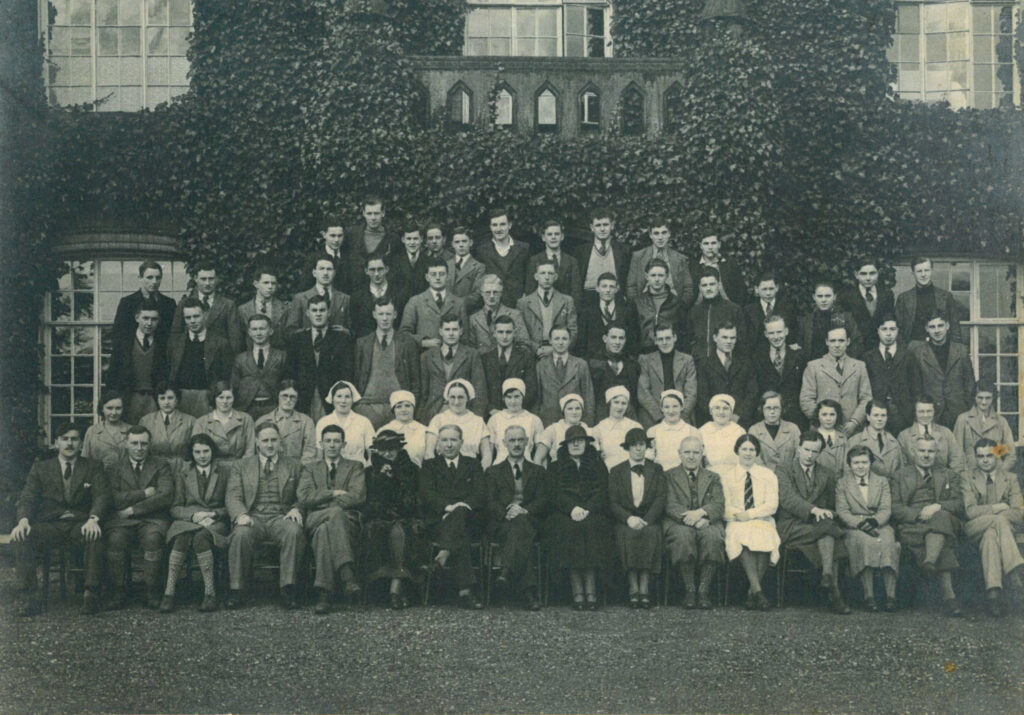Reaseheath: A Notable Year 1935-36
By Victor F. Dutton
Included in Reaseheath Association Magazine 1961
I think it must have been the pleasant memories of happy days at Reaseheath which awakened me one hour before schedule – 1935 and 1936 in company with such colourful personalities as John Meldrum, Harold Morton, Harry Blackburn, Tom Kinsey, Bert Warrington, and other Agricultural students who were known to me by their surnames only – Kermeen, Broadhurst, Aitken, Evans, Lees and Wain, many of who I have not since seen. Dairy students Gilman, Newport, Buckle, Hinton, David Waugh. Horticultural students Briggs, Cocksedge, Jim Salmon and Smallwood. Poultry student George Lloyd.
Many of these have made a real mark for themselves in Agriculture and Horticulture, and a few in other vocations for which the combination of mental and practical training provides an excellent preparation. It was impossible to sit under such lecturers as Messrs. Mercer, Carr, Barratt, Featherstone, McCann, Druce, Louch, Fairbanks, Brown, and Selkirk without being stimulated to think for oneself. The lectures were of a high standard and were frequently highlighted with instances from practical experience. I must confess that not all of us have the lecturers the attention they deserved; a few, myself included, chose to give as much, if not more, attention to sport as to work and study.
Ah but what formidable sportsmen we were. We beat Harper Adams First XI at both football and cricket. John Young hit a glorious six at Harper over the road into a private garden. We beat Nantwich Grammar School 13- 0 at the School – admittedly Mr. Selkirk was playing at Centre Forward with the dash and speed gained in playing rugger for Crewe and Nantwich, but, even without him, I am sure we would have own by a good margin. Kermeen was a wizard with the ball, in Stanley Matthews fashion. He played for the Isle of Man before coming to Reaseheath.
Mr. Selkirk was killed in action in Malaya during the war. Before coming to Reaseheath he played rugby for Scotland.
Recollections of the tennis team introduces the lady students – Miss Nelstrop, Barbara Allen (Mrs. Jim Salmon), Peggy Edge (Mrs. John Rowe), Doreen Hartle (Mrs. Ashworth) and Jean Macphail. I can recall a four mixed doubles team which could hold its own against some skilful and doughty opponents. I must hasten to add that Peggy was the bacteriologist and, therefore, a member of staff. How much we enjoyed doing bacterial counts!
Although I am aware that these thoughts and recollections are only of real interest to our particular year, I make no apology, for I think we were an excellent body of students. This you will already have gathered from our prowess in sport, but the same applied to work and study. I doubt whether any students have asked as many intelligent and difficult questions as did Harold Morton, Harry Blackburn and Tom Kinsey, who all came to Reaseheath with valuable farming experience and knew what to look for and to question in farm demonstrations. They would seldom allow a lecturer to continue until he had clarified a point which appeared to be obscure, expect perhaps to John Meldrum who was the brain of the Agricultural students.
John Young hid his capacity for study by joining in every social activity, but the N.D.A. and N.D.D. gained at Leeds University speak for themselves. John is now farming 700 acres in Norfolk. It is good to read his articles in the ‘Farmer and Stockbreeder’, and to see and hear him on T.V. where it is evident that his talking ability is greater than ever. I expect he has long since ceased to knock out opponents in the welter-weight class.
Mention of the ability to talk recalls Bert Warrington in debate – and that mischievous smile of his as he succeeded in causing his opponent to flounder.
Unfortunately, due to lack of space it is not possible to mention all the Agricultural students who spring to mind, and I suppose John Young hardly deserves to be brought into the picture since he has moved so far away from the seat of his learning! He is, however, doing the dairy industry, and Cheshire, a good turn by producing beef.
I wonder whether many Agricultural students remember draining the pasture adjoining the road to Worleston. The thought of digging through a bank 5ft. deep appalled us, but nothing would daunt Mr. Carr who could throw out the soil and maintain a faster peed that any of us.
Do you recall building calf pens at the Experimental Farm with Mr. Mercer and Mr. Carr who, in their shirt sleeves, showed great prowess in such manual activities as the laying of concrete etc.?
Do you remember getting up at 6am and receiving a cheery welcome from Mr. Jackson or, alternatively, getting up at 6.30am to find him on the warpath, and spending the remaining of the morning trying to keep out of his way? In fairness to Mr. Jackson I will admit, however, that there was no repercussion unless 6.30 showed signs of becoming a bad habit.
I must close by saying a sincere ‘thank you’ to staff and students for a very enjoyable year, and for instilling the enthusiasm with which we returned home to apply our newly acquired knowledge.

